- Home
- /
- Knowsley Village
- /
- History – Knowsley Estate
Knowsley was held by the Lathom family since the twelfth century. In 1385, with the marriage of Isabel de Lathom to Sir John de Stanley, the lands passed to the Stanley family who still hold it today.
Sir John Stanley was made Lord Deputy of Ireland by Richard II and went on to hold a number of distinguished positions including Lord Lieutenant of Ireland, Treasurer of the Royal Household and Lord of the Isle of Man. His grandson Thomas also became Lord Lieutenant of Ireland, and in 1456 was summoned to Parliament as Lord Stanley. The second Lord Stanley (another Thomas) was knighted in 1460 and was created the 1st Earl of Derby by a grateful King Henry VII after his intervention proved decisive in the Battle of Bosworth in 1485.
Although Lathom House, near Ormskirk, was the chief seat of the family (until it’s destruction in the Civil War), the 1st Earl must have kept a great house at Knowsley. He built the ‘Royal Lodging’ in 1495 in honour of Henry VII’s visit. In the late 16th century it had 118 servants including two trumpeters and a Fool named Henry. By the mid 17th century, the Hall was a huddle of buildings, of various dates, materials and uses that ran along the north-south line of the site of the present building. Beyond the Royal Lodging were the kitchens and various court offices, to the east was the chapel with the stables to the north.
Amongst the impressive features within the house are the mantelpiece built to commemorate the loyalty of the 7th Earl, and the chair upon which he knelt for his execution at Bolton in 1651. The Earl’s loyalty to the Crown was quickly forgotten, and it was to be some years until the estate was restored to the family. The 10th Earl practically rebuilt the Hall, adding a colonnade to the extreme southern end of the house, just one of his many legacies which also include the impressive Stucco Room. The 10th Earl was also a keen art-lover and commissioned local artist Hamlet Winstanley to collect artwork from the Continent.
A painting from 1730s shows Knowsley Hall consisting of a regular building of brick with stone dressings, quoins and balustrades all with tall sash windows. The west front was perfectly symmetrical with a projecting centre and a broad pediment. A terrace ran across the width of the house. The open sides of the L-shape were completed by a long wall to the north and an ornamental iron railing with central gates and supporting piers surmounted by the eagles of the family crest. Outside and to the north a new stable building, in the same architectural style was added. This was destroyed in the early 19th century and replaced in 1850.
The east front was more irregular, with a square brick tower projecting from the centre of the building and beyond this was a chapel and an orangery. The southern portion of the east front (the Hesketh Wing) was given its present regular appearance by the 11th Earl.
In the 1780s the 12th Earl, founded the ‘Derby‘ and the ‘Oaks‘ horseraces. The latter taking its name from the Earl’s house near Epsom. At Knowsley he commissioned the architect Robert Adam to draw up some plans for the house, but his plans to practically rebuild the house into a Palace were rejected in favour of more modest improvements, which included a few lodges and gates and a dairy building all of which have since now disappeared. The Earl also employed the Liverpool architect John Foster to create the State Dining Room, measuring some fifty three feet in length and thirty seven feet in width in honour of a visit by King George IV in 1821. Foster also worked on the reconstruction of the kitchens and the Flag Tower.
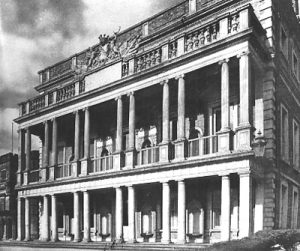
A storey was added along the east front and above the Colonnade to accommodate the growing Victorian household. While beyond the Royal Lodging, Foster’s buildings were increased in scale and weight to surround a quadrangle with towers. A vestibule and porte cochere were added to the centre of the west front. Castellated lodges, Gothic bridges and Swiss boat houses were also added to the Estate.
The 13th Earl, who had a passion for natural history had conservatories, aviaries and animal sheds built around the Estate. His menagerie is reported to have cost £10,000 and contained over 300 species of birds. He was also patron to Edward Lear, who was hired by the Earl to produce illustrations of the wildlife at Knowsley. Lear is best known today for popularising the limerick and ‘The Owl and the Pussy Cat‘ which was originally written for the Earl’s grand-children. The 13th Earl, like many of his predecessors, built up an extensive library, with the Hall having at one time two separate libraries; the mahogany library and a smaller secondary library.
The north front of Knowsley Hall was often used for official photographs of Royal visits including Edward VII and Queen Alexandra in July 1905, King George V and Queen Mary in July 1913, and George VI and Queen Elizabeth in 1938. Such visits were not just private matters, with the estate workers and villagers invited to join-in the celebrations. The Estate was often the focus of local and regional events including the Prescot peace celebrations in July 1919.
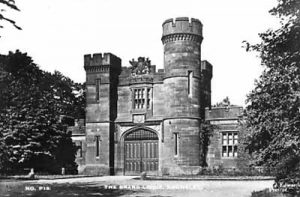
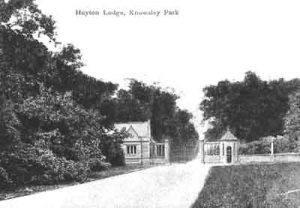
An integral part of the Estate are the many lodges around its perimeter, they would originally have been simple gates but over time became extensive and more ornate. The most impressive of which was the Grand Lodge which was demolished in 1972 during the construction of the M57 Motorway. Other lodges include Huyton and Croxteth lodges which were designed by William Burn in 1837. The main approach to the Hall was through an avenue of trees, even today the approach to the gates is impressive. The Estate is far from ornamental with a number of large farms, including Home Farm, being located within the grounds.
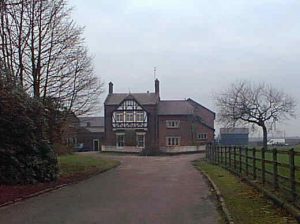
The gardens have always been an important part of the Estate. In 17th century they had consisted of a series of terraces. These were swept away in favour of the landscaped gardens designed by Capability Brown in the mid 1770s. Consisting chiefly of wide lawns and groups of trees, they are enclosed on the east and south sides by a series of small lakes, some of which like the White Man Dam date back to the 1720s.
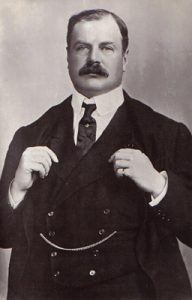
Edward George Villiers Stanley, the 17th Earl set about removing much of the Victorian excess. He attempted to bring all these differing styles into order with the addition of a third storey in the main block and added the family crest, ‘the Eagle and Child’ on its summit. During the Great War, the 17th Earl was responsible for recruiting thousands of local men into what became known as the Liverpool Pals (17th, 18th, 19th and 20th Batallions of the King’s Liverpool Regiment) whereby colleagues who worked together would serve together in the same unit. Lord Kitchener even allowed the Liverpool Pals to have their own cap badge which portrayed the ‘eagle and child’ of the Derby crest. Lord Derby actually paid for and presented silver cap badges to the original Pals volunteers.
In 1958, ten years after his death, a set of memorial gates was erected in his memory in Knowsley Lane, leading to a piece of land donated by his grandson to be used as a playing field.
The grandson mentioned here was Edward John Stanley who became 18th Earl of Derby in 1948 on the death of his grandfather. A lasting legacy of Edward J. Stanley can be found in Knowsley Safari Park which he opened in July 1971. This was a unique venture at that time and the first safari park to be built in close proximity to a large city. The original 3½ mile route through the park was so successful that in 1973 the park was extended and the roadway was lengthened by 1½ miles to accommodate the increased variety of animals on show.
In 1974, Knowsley township became part of the newly formed Metropolitan Borough of Knowsley.
Knowsley Hall’s Earls have always had to adapt to the circumstances of the time and none more so than during the period from late-1960s until 1997 when the Hall’s ground floor was used as a base by Merseyside Police. Following their departure, the current Earl (Edward Richard William Stanley, 19th Earl, who inherited the title and Estate from his uncle in 1994), took up residence there and began the long-term restoration of the house. On completion of the first phase in 1999, Knowsley Hall became far more accessible and one of the most sought-after locations for a number of functions such as conferences, weddings, award ceremonies, private parties and charity events, winning a number of prestigious awards along the way. These functions continue at the Hall today. A further business venture was founded using the modernised buildings on the edge of the Knowsley Estate as commercial office buildings. This became the Stanley Grange Business Village, Ormskirk Road.
The Coronavirus pandemic in 2020 dominated the news for the whole year. A timeline of the events that occurred can be consulted here: COVID-19 National and Local timeline 2020
As the Coronavirus pandemic continued in 2021 with new variants appearing, a further timeline shows the changing situation throughout the year: COVID-19 National and Local timeline 2021
The success of the UK’s vaccination programme meant that coronavirus restrictions were eased in 2022. A summary of COVID-19 information for the year can be found here: COVID-19 National and Local timeline 2022
The UK Government’s Emergency Alerts System is now live and will be used to warn people when lives are in danger, initially to warn of severe weather-related incidents including flooding and provide instructions how to respond to an alert. To check the system, a test took place at 3pm on Sunday 23rd April whereby most people received an official text message on their mobile phones.
The latest COVID-19 information can be found here: COVID-19 National and Local timeline 2023 (to end of May 2023)
